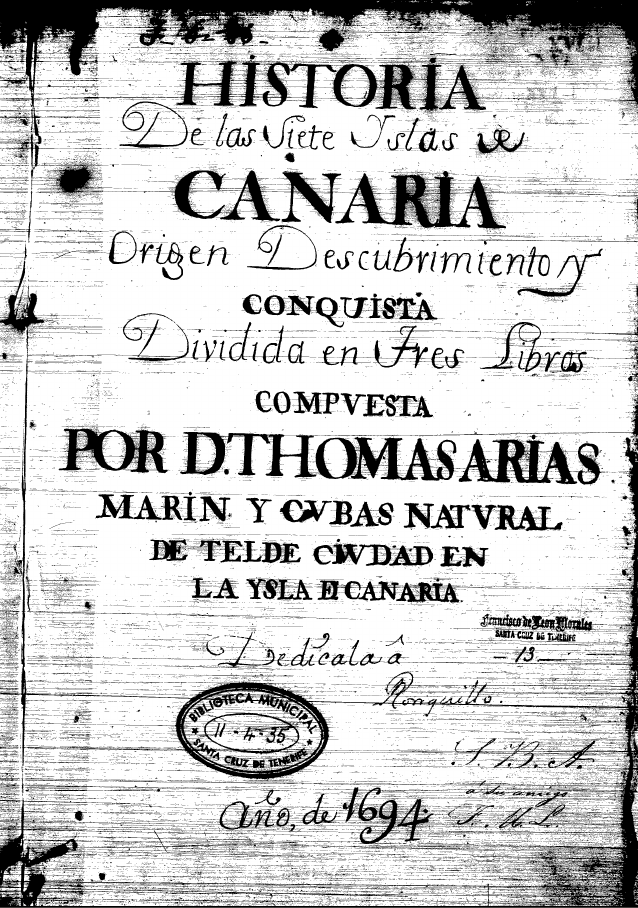
Microfilm image of the title page of the oldest surviving copy –18th century– of Historia de las Siete Yslas de Canaria (1694) by Tomás Marín de Cubas (source: Biblioteca Municipal Central de Santa Cruz de Tenerife, Ancient Collection, catalogue number Ms. 192)
UPDATED POST (2021/08/13)
[…] History by Marín de Cubas, when critically read, therefore constitutes a solid foundation for the knowledge of the prehispanic past of the Canary Islands.
Preface by Professor Juan Régulo Pérez for the 1986 edition of Historia de las siete islas de Canaria[1]ARIAS (1986), p. 28.. This translation by PROYECTO TARHA.
Despite its limited spreading, we are facing what is probably the most important surviving work on the world of the ancient Canarians, right after the work by Brother Juan de Abreu Galindo, even surpassing the latter regarding some key aspects.
Written by Dr. Tomás Marín de Cubas –or Marín y Cubas– (Telde, Gran Canaria, 1643 – Real de Las Palmas, Gran Canaria, 1704), who also holds the merit of being the collator of the oldest known copies of the accounts by Antonio Sedeño and Gómez Escudero, History of the Seven Ysles of Canaria is a work that never ceases to amaze researchers approaching to its pages for this opus provides us with interesting, previously unpublished data on the indigenes and some vivid accounts of known episodes of the Conquest showing that its author had access to information aside that in the other surviving writings dealing with the topic.
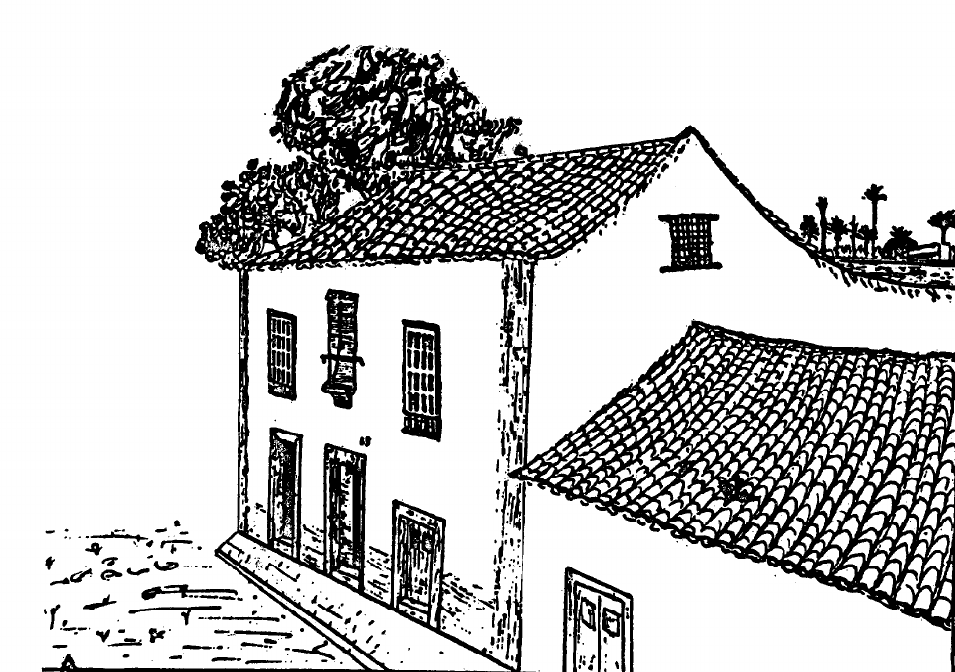
Birthplace of historian Tomás Marín de Cubas in Telde, Gran Canaria island, drew by painter José Arencibia Gil circa 1946 (source: ARIAS (1986), p.37., uncredited)
Two versions for one History
Dr. Marín de Cubas not only composed a draft of his work, but he even previously wrote a number of notes and excerpts devoted to its preparation as those described by Professor Agustín Millares Carlo, which were all kept in the archive of the County of Vega Grande de Guadalupe, Gran Canaria, being microfilmed by then.[2]MILLARES (1935). However, all these documents including the microfilm are currently missing though the latter should be presumably found among the still unclassified collections at El Museo Canario.[3]BARRIOS (2008), pp. 319-320.
In any case, we are more interested here in pointing out the two versions of Marín de Cubas’ work: the draft and the final opus.
History of the Seven Ysles of Canaria (1694)
The final version of the History by Marín de Cubas is dated 1694 though at present only one later copy written by some anonymous copyist in the 18th century survives:
- Historia de las Siete Yslas de Canaria [Manuscrito] : Origen Descubrimiento y Conquista : dividida en Tres Libros / Compuesta por D. Thomas Arias Marin y Cubas natural de Telde ciudad en la ysla de Gran Canaria, año de 1694. (18th century, Biblioteca Municipal Central de Santa Cruz de Tenerife, catalogue number Ms. 192)
- History of the Seven Ysles of Canaria [Manuscript] : Origin Discovery and Conquest : divided in Three Books / Composed by D. Thomas Arias Marin y Cubas born in Telde city on the island of Gran Canaria, year 1694. (This translation by PROYECTO TARHA)
Among other curiosities contained in this work, we would like to highlight the peculiar chronology of the Conquest followed by Marín de Cubas that we have addressed in our essay The Indigenous Pacts of Gran Canaria and Tenerife.
This version though deleting some text chunks in a number of chapters was published in 1901 through 1903 in El Museo Canario journal –volumes 11th-14th–; in 1984, by researcher Francisco A. Ossorio Acevedo –only one out of the three “books” or parts comprising the work–; in 1986, by researchers Ángel de Juan Casañas y María Régulo Rodríguez featuring a preface by Professor Juan Régulo Pérez –lacking the third book– and finally in 1993 by Ossorio Acevedo once again as the so-called Edición Príncipe thus advertised as a comprehensive edition but it does show a number of omissions comparable to those in the El Museo Canario edition.
Unfortunately all editions are currently out of print although the 1986 issue is available in PDF due to Memoria Digital de Canarias. In any case let us note that currently there is no such a comprehensive edition of this outstanding opus by Marín de Cubas in despite of the existence of three transcriptions seemingly complete: two of them kept at El Museo Canario –respectively by Juan Padilla Padilla (1875) and Antonio Hernández Rivero (1946)– and a third one belonging to the Ancient Collection at Biblioteca Municipal Central de Santa Cruz de Tenerife signed by Arturo López de Vergara y Albertos (1940-41). Plus there is a fourth copy made in 1878 by Agustín Millares Torres also kept at El Museo Canario but lacking the three last chapters which were not been transcribed.
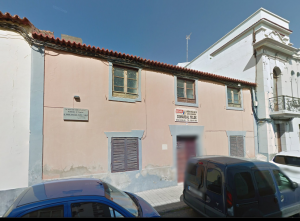
The commemorative plaque on this house’s facade claimed it to be the birthplace of Dr. Marín de Cubas in the presently known as Julián Torón Street in Telde (source: Google Maps)
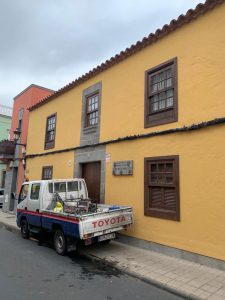
However Marín de Cubas’ true birthplace is a house almost opposite the former where the plaque was moved to on 23th April 2022 (source: Antonio Mª González Padrón, Official Chronicler of Telde)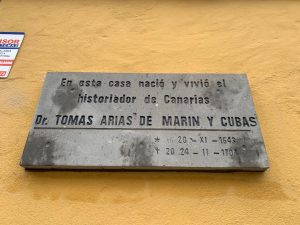
Conquest of the Seven Ysles of Canaria (1687)
This version is really a draft of the aforementioned work composed out of a compilation made of historiographic fragments by other authors –some of them unknown– that Marín de Cubas used to approach the final wording of his History as well as data obtained from his field research. But unlike the latter work we do have at least a full set of images of the 1687 manuscript handwritten by Marín de Cubas himself.
Despite its preliminary nature, this version has a great value per se which was already pointed out by Professor Juan Régulo Pérez in his preface to the 1986 edition, as it is plenty of ethnographic data that were not included in the 1694 document. This work that remained unpublished has been recently published as a critical edition prepared by us.
Out of the missing original manuscript, which was kept at the archive of the County of Vega Grande de Guadalupe, one partial set of photographs is kept at El Museo Canario and another one identical and complete at Biblioteca Insular de Gran Canaria, Miguel Santiago Collection, catalogue number MS A57/03(2).
Also there are two 1936 unpublished transcriptions of the document: the one most used by researchers is that due to Dr. Pedro Hernández Benítez which has a photocopy with no catalogue number available at El Museo Canario‘s archive and a second, much less noticed one by Dr. Miguel Santiago Rodríguez belonging to the aforementioned Miguel Santiago Collection, catalogue number MS A57/03(1).

Title heading handwritten by Marín de Cubas on the first folio of his Conquista de las Siete Yslas de Canaria (1687) (source: Biblioteca Insular de Gran Canaria, Miguel Santiago Collection, catalogue number MS A57/03(2))
Special thanks
We would like to thank Professor José Barrios García for his comments and corrections on this post.
Antonio M. López Alonso
References
- Arias Marín de Cubas, T. (1986). Historia de las siete islas de Canaria. Las Palmas de Gran Canaria: Real Sociedad Económica de Amigos del País de Gran Canaria.
- Barrios García, J. (2008). El microfilme Millares Carló (1934-1935). En Morales Padrón, F., editor, XVII Coloquio de Historia Canario-Americana, vol. 1, pp. 314–322. Cabildo de Gran Canaria.
- Millares Carlo, A. (1935). Noticia y descripción de un códice interesante para la historia de Canarias. El Museo Canario, vol. 3, nº 7, pp. 67-98. Las Palmas – Madrid: El Museo Canario.
